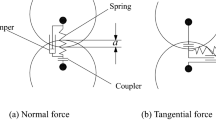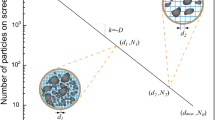Summary
As part of an effort to understand the mechanics of fine fragment formation in coal, which is important in studies of respirable dust due to mining, fracture toughness measurements and the strain energy density (SED) theory were applied to calculate the crush zone size under a cutting tool in coal. This zone is the major source of fine fragments in the 1 to 10 µm size range. The model used in these calculations is a boundary element program containing a failure criterion based on the SED theory. The boundary element program calculates linear elastic stresses at numerous points in the coal material ahead of a cutting bit. These stresses are then input to a subroutine called critical flaw length and orientation (CFLO) which uses the SED theory to determine the CFLO for a small crack at the boundary element stress computation point. The extent of crushing is based on earlier postulates about the role of inherent flaws in a fragmentation process. To form 1 to 10 µm fragments requires firstly a local stress strong enough to activate flaws with a characteristic length less than 1 to 10 µm and secondly, a flaw density sufficient to provide an average spacing between flaws also on the order of 1 to 10 µm. The locus of active 10 µm flaws represents the maximum possible extent of fine fragmentation in the 10 µm or less size range assuming that a sufficient inherent flaw density exists. The approach offers a first order approximation to the extent of crushing under a tool tip. The size and shape of the crush zone volume is affected by the attack angle and geometry of the tool.
Similar content being viewed by others
References
Cook, N.G.W., Hood, M. and Tsai, F. (1984) Observations of crack growth in hard rock loaded by an indenter,International Journal of Rock Mechanics and Mining Sciences & Geomechanics Abstracts,21 3, 97–107.
Crouch, S.L. and Starfield, A.M. (1983)Boundary Element Methods in Solid Mechanics, George Allen & Unwin, London, 322 pp.
Evans, I. and Pomeroy, C.D. (1966)The Strength, Fracture and Workability of Coal, Pergamon Press, New York, 277 pp.
Forsythe, G.E., Malcolm, M.A. and Moler, C. B. (1977)Computer Methods for Mathematical Computations, Prentice-Hall, Englewood Cliffs, N.J., 259 pp.
Friedman, M. and Ford, L.M. (1983) Analysis of rock deformation and fractures induced by rock cutting tools used in coal mining,Proceedings: 24th U.S. Symposium on Rock Mechanics, Texas A&M University, pp. 713–723.
Gdoutos, E.E. (1984)Engineering Application of Fracture Mechanics, VII, Problems of Mixed Mode Crack Propagation, Martinus Nijhoff Pub., Boston, 204 pp.
Hanson, B.D. and Roepke, W.W. (1979)Effect of Symmetric Bit Wear and Attack Angle on Airborne Respirable Dust and Energy Consumption, USBM RI 8395, 24 pp.
Howarth, D.F. and Bridge, E.J. (1988a) Microfracture beneath blunt disc cutters in rock,International Journal of Rock Mechanics and Mining Sciences & Geomechanics Abstracts,25 1, 35–38.
Howarth, D.F. and Bridge, E.J. (1988b) Observation of cracks at the bottom of percussion and diamond drill holes,International Journal of Rock Mechanics and Mining Sciences & Geomechanics Abstracts,25 1, 39–44.
Larchuk, T.J., Conway, J.C. and Kirchner, H.P. (1985) Crushing as a mechanism of material removal during abrasive machining,Journal of the American Ceramics Society,68 4, 209–215.
Roepke, W.W., Lindroth, D.P. and Myren, T.A. (1976)Reduction of Dust and Energy During Coal Cutting Using Point Attack Bits, USBM RI 8185, 56 pp.
Sih, G.C. (1974) Strain energy density factor applied to mixed mode crack problems,International Journal of Fracture,10 3, 305–321.
Zipf, R.K. (1988)The Mechanics of Fine Fragment Formation in Coal, Ph.D. Dissertation, The Pennsylvania State University, 302 pp.
Zipf, R.K. and Bieniawski, Z.T. (1988a) A Fundamental Study of Respirable Dust Generation in Coal,Mining Science and Technology, submitted for publication.
Zipf, R.K. and Bieniawski, Z.T. (1988b) Mixed Mode Fracture Toughness Testing of Coal,International Journal of Rock Mechanics and Mining Sciences and Geomechanics Abstractrs, submitted for publication.
Author information
Authors and Affiliations
Rights and permissions
About this article
Cite this article
Zipf, R.K., Bieniawski, Z.T. Estimating the crush zone size under a cutting tool in coal. International Journal of Mining and Geological Engineering 6, 279–295 (1988). https://doi.org/10.1007/BF00880927
Received:
Issue Date:
DOI: https://doi.org/10.1007/BF00880927




